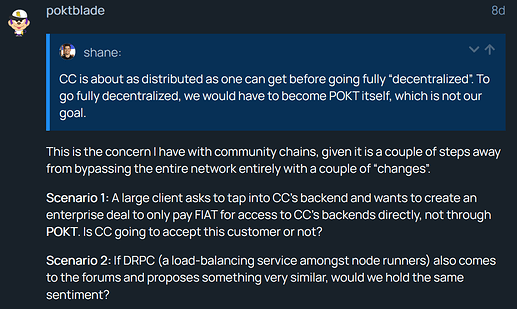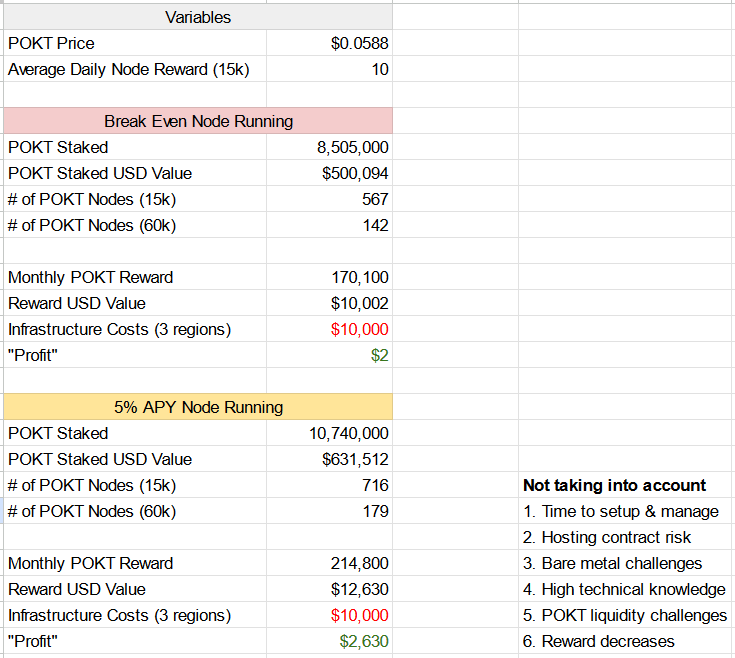Following my DAN proposal and the announcement of Community Chains, there has been a lot of conversation about chain node pooling. To get into the specific of the pros and cons of chain node pooling, I wanted to create a dedicated topic and provide the history of the concept as I’ve experienced it since joining POKT in 2019.
However, with the announcement of CC, there has been a lot of FUD going around about chain node pooling (and specially the existence of CC). While all comments and feedback are welcome, let us not stoop to projecting nefarious motives on folks and focus on a productive discussion. I’ve been rather shocked with the lengths to which folks have been willing to project on our CC solution, when it’s development has been openly talked about since November in Node Runner Community Calls.
I believe most of the aggression is unfounded as many don’t understand the history behind the concept, so I wanted to share what I’ve experienced and open up a space for all to discuss.
Background
Chain node sharing has always been a topic POKT folks discuss. The idea of reducing costs make sense in any business or ecosystem, and pooling chain nodes to reduce costs is just basic logic with POKT economic.
Since the launch of mainnet in August 2020 and up until until Q3 2021, POKT primarily had traffic on ETH as few chains were actively supported. Chain infrastructure costs were very low for providers. The introduction of Settlers of New Chains opened the door to adding new chains and incentivizing node runners to spin up chain nodes with a reasonable assurance they would get some rewards.
3x Infrastructure Costs
With the increase in new chains being added to POKT, running chain infrastructure began to increase. Despite the increasing chain infrastrutre costs, at the time you could easily run POKT nodes at a profit. However, even at that time I still heard of folks that begun chain node sharing.
Q3 2022 the Reward/Cost ratio started to dramatically fall as some providers created their own closed-source clients to do geo-meshing. Fortunately POKTScan released an open-source version that enabled anyone to participate (see the history of that here), but that now meant that in order to have network average rewards, you now have to deploy chain infrastructure in 3 regions.
The math is simple in regards to what is required to be profitable:
Q2 2022 = 1 POKT node required access to 1x chain nodes
Q3 2022 = 1 POKT node requires access to 3x chain nodes (as it needs chain node access in each region)
That 3x in infra costs for 1 POKT node crushed the independent node runner market. No one today can profitably run nodes without having chain infrastructure in 3 regions. POKT has all but lost an independent node running community (folks running nodes with their own POKT, not a provider running other folks nodes) with this extreme rise in infra costs.
LeanPOKT reduced the cost of POKT nodes dramatically (kuddos to POKTFund and ThunderHead) , while at the same time we saw a 3x increase in chain infrastructure costs with the introduction of closed-source geo-meshing (kuddos to those providers earning 2x to 3x the rewards last summer). Had geo-meshing been openly discussed prior to development, then there could have been region locking brought on-chain to protect against increasing chain infrastructure costs (as @RawthiL suggested for v1), or it could have been EASILY enacted via the Portal (which could still be done today, but I think “some” providers may not like that ![]() ).
).
NOTE: This post IS NOT about debating the ethic or economics of geo-meshing, or trying to directly reverse it’s impact. This post is in fact about chain node pooling ONLY and I mention geo-meshing only for the purpose of showing it’s impact infrastructure costs. Please direct comments about geo-meshing history to another post. Thank-you ![]()
Current Over-Provisioning
With 3x the infrastructure being deployed on POKT, came extreme over provisioning just to be profitable. As I mentioned in DAN, only 6 well run Ethereum Erigon Nodes are technically needed to handle all of POKT’s ETH traffic, yet every node runner needs Ethereum infra in every region, adding a LOT of chain over-provisioning. How many ETH nodes do folks think are within the POKT ecosystem? 50+ makes sense to me when you look at all the providers.
These nodes require POKT liquidation to pay for the infrastructure. I don’t know one bare-metal hosting company that accepts POKT as a form of payment.
Chain Node Pooling Today
PNI first started talking about chain node pooling at the POKT State of Union this past November. They explained it as a way to reduce infrastructure costs, allow there to be more POKT node owners, and ensure best network wide QoS. It was referenced and mentioned by 3 or 4 PNI presenters and was said to be a big focus on 2023. More recently Michael talked extensively about measures they are considering to reduce chain nodes on POKT.
Beyond that, chain node pooling is already happening today, though it is not being transparently broadcast. I’m aware of a number of providers that either share chain nodes, or provide chain node access to other select providers. It’s a closed club.
It is also frequently talked about in Node Runner Community Calls as a way to enable more folks to be POKT node owners. The topic really picked up in Q3 2022 once folks heard about geo-meshing from POKTScan. We in-fact started building CC in October and first shared about it in November. Since then we have been giving updates on most of the Node Runners Community Calls.
Who’s More Dangerous… POKT Providers or Chain Pooling  ?
?
OK, let’s address the FUD that has been going around with logic ![]()
The $500k Problem
FACT: POKT is dominated by hosting providers and it is nearly impossible for anyone with less than $500k of POKT generate any kind of “profit” on POKT as an independent node runner.
Recently in a Node Runner’s Community Call, a successful node runner mentioned that their infra costs are around $10k a month. They run all bare-metal and their costs do track with other providers. Sure, I do know there are some VERY SAVVY node runners out there that run for less, but that is the outliers and they are dedicated to their trade (which kudos to them ![]() ).
).
Using the $10k expense, here is a calculation on the amount of POKT it requires to stake to break even, and the amount required to make 5% APY with today’s conditions (not accounting for SER reward reducing).
TLDR: Someone would need to stake $631,512 worth of POKT to get 5% APY ![]()
Because of this, this is today’s reality:
POKT = POKT Hosting Providers and POKT Hosting Providers = POKT
These services are the ONLY way to participate in POKT if you do NOT have $631k + a high level of technical knowledge and a healthy apatite for pain.
So what options should there be until v1? Currently there is only POKT Hosting Providers, and CC is now the first to offer distributed chain node pooling. However some folks seem intent on sowing doubt, so let’s get down the details.
Centralized POKT Nodes or Centralized Chain Nodes?
How do they compare?
| Features | POKT Provider | Chain Node Pooling |
|---|---|---|
| Own chain nodes | ||
| Own POKT nodes | ||
| Can deploy your own chains | ||
| Choose Chains to serve | ||
| Validator Voting |
Chain node pooling clearly has an advantages, and in every way align more with POKT’s ethos. It aligns with POKT ethically and economically. While I have been perfectly content with the existence of POKT Providers, I do not get the arguments against calling chain node pooling “dangerous”.
Legit Conversation
Now, let us now have a legit conversation. I have responded to every meaningful remark in the DAN proposal, and yet the same straw man arguments keep coming up. Since the FUD is being directed at CC and not directed at the chain node pooling concept itself, I’d like to separate the two and hear some logical arguments about their pros and cons. This way we can know as a community if folks have an issue with chain node pooling itself.
I’ve been making free node software for the POKT community since 2020, and will be happy to lend my experience in the independent node running space, to this conversation ![]()



